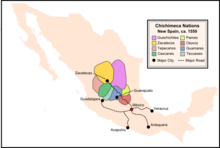Caxcan

The Caxcan were a partly nomadic indigenous people of Mexico. Under their leader, Francisco Tenamaztle, the Caxcan were allied with the Zacatecos against the Spaniards during the Mixtón Rebellion. During the rebellion, they were described as "the heart and the center of the Indian Rebellion". They were famously led by Tenamaxtli. After the rebellion, they were at constant target by the Zacatecos and Guachichiles due to their ceasefire agreement with the Spaniards. Their principal religious and population centers were at Teul, Tlaltenango, Juchipila, and Teocaltiche.
Over time, the caxcans lost their culture due to warfare, disease, and marriage to non-caxcans. There are no people with full caxcan heritage today.
Their language was part of the uzo-atec language family.
Their elected rulers were called tlatoani. Caxcan society was divided up into several different city-states.
The Mixtón Rebellion
The Chichimeca War
Post 1900s
The Council of the Caxcan Indians was formed in the 1920s by Juana Belén Gutiérrez de Mendoza, a Caxcan from Durango.[1] She also published Alto!, a book which stressed Mexican Nationalism through indigenous roots and, even after the alleged extinction of the Caxcan people, is quoted as saying "We do not recognize the right of any race to impose its civilization upon us" as a way to promote indigeneity.[1]
Notes
